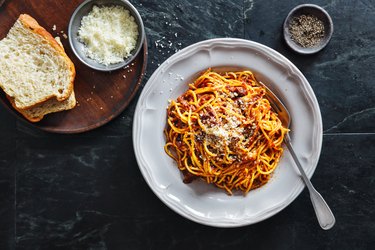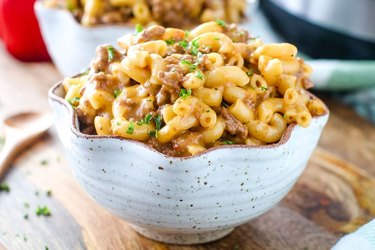
You've probably heard a whole heap of warnings about processed foods and how they're harmful to your health and why you should ditch them from your diet.
But if you follow this blanket advice and pass over all processed foods, you'd be doing your health a disservice. While some ultra-processed fare like chips and cured meats are innutritious, other less processed food varieties can be an amazing addition to your daily diet.
Video of the Day
Video of the Day
Take chickpea pasta. While it's processed (chickpeas are dried, ground into flour, then formed into noodles), it's one of the most nutrient-dense foods on the planet. This means that noshing on these non-traditional noodles boasts a boatload of benefits for your body.
Here, experts share the health benefits of chickpea pasta, plus tasty tips to incorporate it into your weekly eating plan.
What Does 'Processed' Mean, Anyway?
"The word 'processed' gets a bad rap," says Leslie Langevin, RD, author of The Anti-Inflammatory Kitchen Cookbook and co-owner of Whole Health Nutrition.
But processed simply means that a food is changed, prepared or packaged in a particular way prior to landing on your plate, according to the American Heart Association (AHA).
This processing can range from minimally processed (like frozen fruits or pre-cut veggies) to highly or ultra-processed (like sugary energy drinks and cakes).
We usually hear about the latter's limitations on our health. Indeed, ultra-processed foods contain added sodium, sugars, oils, colors and preservatives. In fact, commercially processed (and restaurant foods) account for most of the sodium (70 percent) in the average American diet, per the AHA.
But this is just one side of the processed spectrum, and changing a food isn't always a negative thing.
For example, some processing involves adding nutrients such as fiber, calcium or vitamin D, or packaging foods to help stop spoilage and enhance food safety (think: canning produce, pasteurizing milk products or vacuum-packing meats), according to the AHA.
Certain types of processing can also increase the digestibility or absorption of nutrients in foods, Langevin says. Examples of this include grinding oats into flour, sprouting grains or soaking beans before cooking them, she says.
And sometimes processing a food — like chickpeas — can create new ways to eat and enjoy it without sacrificing its nutrient profile. "Eating chickpeas in the shape of a pasta noodle both delivers the same nutrition as a chickpea in its whole form and in a fun way to eat for the whole family," Langevin says.
6 Reasons Why Chickpea Pasta Is Healthy
Chickpea Pasta vs. Wheat Pasta Nutrition
Per 2 oz. | |||
|---|---|---|---|
Calories | 196 | 213 | 202 |
Total fat | 3.1 g | 1 g | 1 g |
Saturated fat | 0 g | 0 g | 0 g |
Total carbs | 28.9 g | 41.5 g | 42.5 g |
Dietary fiber | 5.2 g | 2 g | 6.1 g |
Total sugar | 1 g | 2 g | 2 g |
Protein | 12.4 g | 8.1 g | 6.1 g |
The health perks of chickpea pasta are plentiful. Here are just a few:
1. It Promotes Healthy Digestion
While it depends on the particular brand, the typical chickpea pasta provides more gut-friendly fiber than white or wheat pasta (around 8 grams per serving, compared to 2 and 5 grams, respectively), says Susie Polgreen, RD, CD, a dietitian with Whole Health Nutrition.
Here's why that's a good thing for your gut: Soluble and insoluble fiber help to bulk up your stool and move it along the digestive tract (read: regular, healthy bowel movements), Polgreen says.
Plus, fiber is also a stellar source of prebiotics, which help to feed probiotics (or "good" gut bacteria), Polgreen says. In other words, fiber-rich chickpea pasta is marvelous for your microbiome too.
And with up to 8 grams per serving, just one portion of this legume pasta can help you reach your daily target for fiber of 25 to 38 grams, Langevin says.
2. It Can Help Stabilize Your Blood Sugar
If you're longing for linguine, but you need to watch your blood sugar, chickpea pasta is the perfect low-glycemic alternative.
"Because of its high protein and fiber content, chickpea pasta promotes a slower release of glucose into the bloodstream, making it a better choice for blood sugar management than white or wheat pasta," Polgreen says.
Put another way, the fiber in complex carbs like chickpea pasta slows down digestion, whereas your body breaks down and quickly absorbs low-fiber simple carbs — like white pasta — which can send your blood sugar surging and dipping after you dine.
3. It's Linked to a Lower Risk of Chronic Disease
Your high-fiber plate of chickpea pasta may also help protect your heart.
"Eating adequate fiber has been shown to be very important for overall health and disease prevention," Langevin says. Specifically, a high-fiber diet may reduce your risk of certain cancers and heart disease, she says.
Case in point: A February 2019 series of systematic reviews and meta-analyses in The Lancet observed that people on a fiber-rich eating plan (25 to 29 grams of fiber per day) had a 15 to 30 decreased risk of early death due to any cause (including heart issues) and a lower risk of coronary heart disease, stroke, type 2 diabetes and colorectal cancer (versus those who ate less fiber).
Similarly, substituting some plant-based protein (like chickpea pasta) for animal protein (especially red meat) may help support your long-term health. Munching on more meatless meals is linked to a decreased risk of certain cancers and heart-related diseases, according to an August 2019 study in the Journal of the American Medical Association Internal Medicine.
4. It Can Help You Build Lean Muscle
When you consider foods for muscle building, you probably think of meat. But chickpea pasta is a plant-based protein powerhouse, and that's great news for your muscles.
Depending on the brand, chickpea pasta can provide nearly double the protein of regular white pasta and even more than gluten-free rice pastas, which only have around 3 grams of protein per serving, Langevin says.
To build and maintain healthy muscle, Langevin recommends eating 20 to 30 grams of protein at each meal. And with up to 14 grams of protein per portion, chickpea pasta can help you meet this protein range, especially if you follow a plant-based or vegan eating pattern. Yep, a hefty bowl of high-quality protein chickpea noodles can serve as a staple meatless dinner.
But keep in mind: "Like most other beans, chickpeas are incomplete proteins on their own," Langevin says. That means they're missing two essential amino acids (methionine and cysteine) as compared to meat (which contains all nine essential amino acids), she explains.
But this shouldn't deter you from dining on legume pasta. You can still eat your chickpea noodles and get your essential amino acids too. "To make a complete protein out of chickpea pasta, simply serve some toasted walnuts or seeds with the dish or a few whole grains in the same meal," Langevin says.
5. It Supports Weight Loss and Weight Maintenance
If your goal is to shed a few pounds (or maintain your current weight), chickpea pasta can help you do just that.
Once again, fiber is the fundamental factor here. That's because fiber helps you feel fuller during and after your meal, Langevin says. Fiber keeps your stomach satisfied and curbs cravings, which are all important for weight loss or weight maintenance.
Protein is another contributing component to this equation as well. Protein takes longer to digest than carbs, so it can also help you feel satiated longer and slash the belly rumbles that make your reach for calorie-rich foods.
6. It’s an Allergy-Friendly Alternative
For people with food allergies or sensitivities, chickpea pasta can be a satisfying and safe substitute for traditional pasta.
"Legume-based pastas can be a great alternative for those with gluten and/or wheat sensitivities," Polgreen says.
That's because chickpea pasta is naturally gluten-free, Langevin says. It's an even better option than gluten-free rice pastas, which are low in fiber and high in carbs, she adds.
Just be sure to double-check the ingredients list on the back of the box. While some chickpea pasta brands use just chickpea flour, others may use a combination of different flours that may not be gluten-free, Polgreen says.
How to Add Chickpea Pasta to Your Diet
"Chickpea pasta is easy to incorporate in any dish that you might normally use pasta," Langevin says. Here are some simple ways to start cooking with the bean-based pasta:
- Toss it with pesto, tomato or a light alfredo sauce
- Add it to a tuna salad to create a terrific taste and texture combo
- Use it as a base for pasta salad with a variety of veggies and an oil-and-vinegar dressing
- Mix last night's leftovers into a breakfast frittata for an extra tidbit of texture and protein boost
Was this article helpful?
150 Characters Max
0/150
Thank you for sharing!
Thank you for your feedback!


